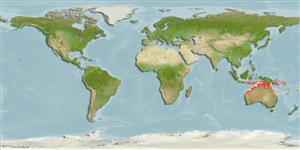Common names from other countries
>
Carangiformes (Jacks) >
Carangidae (Jacks and pompanos) > Caranginae
Etymology: Caranx: French, carangue, the name of a Caribbean fish; 1836 (Ref. 45335).
More on authors: Alleyne & Macleay.
Environment: milieu / climate zone / depth range / distribution range
Sinh thái học
Biển; Thuộc về nước lợ Cùng sống ở rạn san hô; Mức độ sâu 7 - 63 m. Tropical; 7°S - 23°S
Southwest Pacific: Arafura Sea (Ref. 9819), northern Australia, from the Timor Sea in the west (Ref. 6905) to the Gulf of Papua in the north (Ref. 6906) and on the eastern coast of Australia as far south as Gladstone (Ref. 6907).
Length at first maturity / Bộ gần gũi / Khối lượng (Trọng lượng) / Age
Maturity: Lm ?, range 11 - ? cm
Max length : 66.0 cm TL con đực/không giới tính; (Ref. 2334)
Adults are common in prawn trawling grounds and are most abundant closer to the coast. They feed predominantly on benthic prey consisting mainly of crustaceans and teleosts (Ref. 6908). They exhibit diel vertical migration, possibly following the movement of crustaceans along the water column. Continuous spawning during the year (Ref. 6904). Juveniles are often encountered in estuaries. Caught mainly on hook-and-line and by spearing; also with gill nets and other artisanal gear. This species is an excellent sports fish (Ref. 9894).
Randall, J.E., G.R. Allen and R.C. Steene, 1990. Fishes of the Great Barrier Reef and Coral Sea. University of Hawaii Press, Honolulu, Hawaii. 506 p. (Ref. 2334)
IUCN Red List Status (Ref. 130435)
CITES (Ref. 128078)
Not Evaluated
Threat to humans
Harmless
Human uses
Các nghề cá: buôn bán nhỏ; cá để chơi: đúng
Các công cụ
Special reports
Download XML
Các nguồn internet
Estimates based on models
Preferred temperature (Ref.
115969): 26.2 - 28.6, mean 27.7 (based on 326 cells).
Phylogenetic diversity index (Ref.
82804): PD
50 = 0.5000 [Uniqueness, from 0.5 = low to 2.0 = high].
Bayesian length-weight: a=0.02455 (0.01365 - 0.04414), b=2.92 (2.76 - 3.08), in cm Total Length, based on LWR estimates for this species & (Sub)family-body (Ref.
93245).
Mức dinh dưỡng (Ref.
69278): 3.8 ±0.0 se; based on diet studies.
Thích nghi nhanh (Ref.
120179): Trung bình, thời gian nhân đôi của chủng quần tối thiểu là 1.4 - 4.4 năm (K=0.30; Fec: >8,000).
Fishing Vulnerability (Ref.
59153): Moderate vulnerability (36 of 100).
